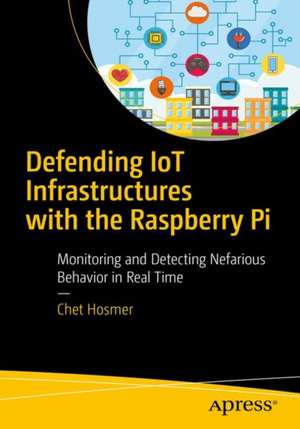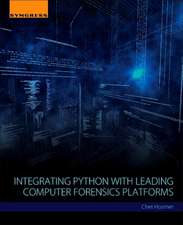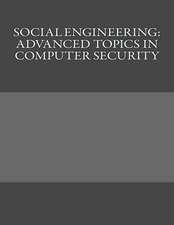Defending IoT Infrastructures with the Raspberry Pi: Monitoring and Detecting Nefarious Behavior in Real Time
Autor Chet Hosmeren Limba Engleză Paperback – 4 iul 2018
Defending IoT Infrastructures with the Raspberry Pi provides techniques and scripts for the discovery of dangerous data leakage events emanating from IoT devices. Using Raspbian Linux and specialized Python scripts, the book walks through the steps necessary to monitor, detect, and respond to attacks targeting IoT devices.
There are several books that cover IoT, IoT security, Raspberry Pi, and Python separately, but this book is the first of its kind to put them all together. It takes a practical approach, providing an entry point andlevel playing field for a wide range of individuals, small companies, researchers, academics, students, and hobbyists to participate.
What You’ll Learn
- Create a secure, operational Raspberry Pi IoT sensor
- Configure and train the sensor using “normal” IoT behavior
- Establish analytics for detecting aberrant activities
- Generate real-time alerts to preempt attacks
- Identify and report data-leakage events originating from IoT devices
- Develop custom Python applications for cybersecurity
Cybersecurity specialists, professors teaching in undergraduate and graduate programs in cybersecurity, students in cybersecurity and computer science programs, software developers and engineers developing new cybersecurity defenses, incident response teams, software developers and engineers in general, and hobbyists wanting to expand the application of Raspberry Pi into both IoT and cybersecurity
Preț: 153.47 lei
Preț vechi: 191.84 lei
-20% Nou
Puncte Express: 230
Preț estimativ în valută:
29.37€ • 30.55$ • 24.25£
29.37€ • 30.55$ • 24.25£
Carte disponibilă
Livrare economică 24 martie-07 aprilie
Preluare comenzi: 021 569.72.76
Specificații
ISBN-13: 9781484236994
ISBN-10: 1484236998
Pagini: 230
Ilustrații: XV, 178 p. 68 illus.
Dimensiuni: 155 x 235 mm
Greutate: 0.28 kg
Ediția:1st ed.
Editura: Apress
Colecția Apress
Locul publicării:Berkeley, CA, United States
ISBN-10: 1484236998
Pagini: 230
Ilustrații: XV, 178 p. 68 illus.
Dimensiuni: 155 x 235 mm
Greutate: 0.28 kg
Ediția:1st ed.
Editura: Apress
Colecția Apress
Locul publicării:Berkeley, CA, United States
Cuprins
Chapter 1: IoT Vulnerabilities.- Chapter 2: Classifying and Modeling IoT Behavior.- Chapter 3: Raspberry Pi Configuration and PackerRecorder.py Enhancements.- Chapter 4: Raspberry Pi as a Sensor.- Chapter 5: Operating the Raspberry Pi Sensor .- Chapter 6: Adding Finishing Touches.- Chapter 7: Future Considerations.- Appendix: Obtaining the Python Source Code.- Glossary.-
Notă biografică
Chet Hosmer is the founder of Python Forensics, Inc., a nonprofit organization focused on the collaborative development of open source investigative technologies using the Python programming language. He has been researching and developing technology and training related to forensics, digital investigation, and steganography for over two decades. He has made numerous appearances to discuss emerging cyber threats, including National Public Radio's Kojo Nnamdi show, ABC's Primetime Thursday, NHK Japan, CrimeCrime TechTV, and ABC News Australia. He has been a frequent contributor to technical and news stories relating to cybersecurity and forensics and has been interviewed and quoted by IEEE, The New York Times, The Washington Post, Government Computer News, Salon.com, and Wired Magazine.
Chet has authored five books within the cybersecurity domain, ranging from data hiding to forensics. He serves as a visiting professor at Utica College in the cybersecurity graduate program. Heis also an adjunct faculty member at Champlain College in the Digital Forensic Science masters program. He delivers keynote and plenary talks on various cybersecurity-related topics around the world each year.
Textul de pe ultima copertă
Apply a methodology and practical solutions for monitoring the behavior of the Internet of Things (IoT), industrial control systems (ICS), and other critical network devices with the inexpensive Raspberry Pi. With this book, you will master passive monitoring and detection of aberrant behavior, and learn how to generate early indications and warning of attacks targeting IoT, ICS, and other critical network resources.
Defending IoT Infrastructures with the Raspberry Pi provides techniques and scripts for the discovery of dangerous data leakage events emanating from IoT devices. Using Raspbian Linux and specialized Python scripts, the book walks through the steps necessary to monitor, detect, and respond to attacks targeting IoT devices.
There are several books that cover IoT, IoT security, Raspberry Pi, and Python separately, but this book is the first of its kind to put them all together. It takes a practical approach, providing an entry point and level playing field for a wide range of individuals, small companies, researchers, academics, students, and hobbyists to participate.
What You’ll Learn:
Defending IoT Infrastructures with the Raspberry Pi provides techniques and scripts for the discovery of dangerous data leakage events emanating from IoT devices. Using Raspbian Linux and specialized Python scripts, the book walks through the steps necessary to monitor, detect, and respond to attacks targeting IoT devices.
There are several books that cover IoT, IoT security, Raspberry Pi, and Python separately, but this book is the first of its kind to put them all together. It takes a practical approach, providing an entry point and level playing field for a wide range of individuals, small companies, researchers, academics, students, and hobbyists to participate.
What You’ll Learn:
- Create a secure, operational Raspberry Pi IoT sensor
- Configure and train the sensor using “normal” IoT behavior
- Establish analytics for detecting aberrant activities
- Generate real-time alerts to preempt attacks
- Identify and report data-leakage events originating from IoT devices
- Develop custom Python applications for cybersecurity
Caracteristici
The first book to put together coverage of IoT, Raspberry Pi, Python, and cybersecurity Addresses the critical need to secure IoT devices and their rapidly growing infrastructure Provides a unique use of the application of the Raspberry Pi





















